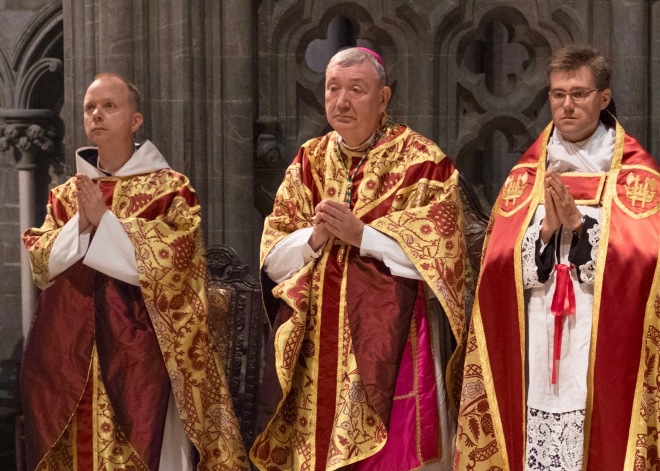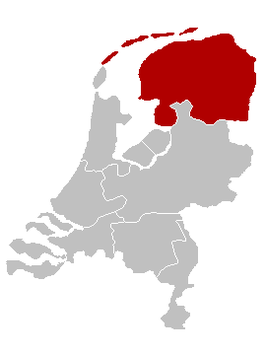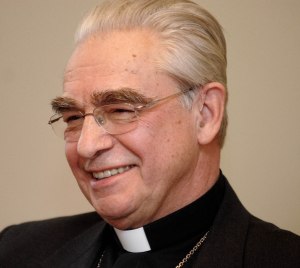After a vacancy that lasted just over a decade, the Territorial Prelature of Trondheim will finally have a bishop-prelate again. Since 2009, when Bishop Georg Müller was forced to retire (more about that here), the pastoral responsibility for the central Norwegian circumscription was in the hands of the bishop of Oslo, Bernt Eidsvig, who served as apostolic administrator.
 The new bishop of Trondheim is a Norwegian, but coming home by way of England, where he has been the abbot of the Mount Saint Bernard Abbey, a Trappist monastery in Leicestershire. Bishop-elect Erik Varden is, despite his role as abbot, young for a bishop. At 45, he is the fifteenth-youngest bishop in the world, and certainly the youngest in Scandinavia and Europe (if we exclude Ukraine, a country which can boast seven bishops aged 43 and younger). Additionaly, Fr. Varden has also not been a priest or a religious for very long. He entered the Order of the Cistercians of the Strict Observance in 2002, made his first profession in 2004, his solemn vows in 2007 and was ordained a priest in 2011. He has been the abbot of Mount St. Bernard since April of 2015.
The new bishop of Trondheim is a Norwegian, but coming home by way of England, where he has been the abbot of the Mount Saint Bernard Abbey, a Trappist monastery in Leicestershire. Bishop-elect Erik Varden is, despite his role as abbot, young for a bishop. At 45, he is the fifteenth-youngest bishop in the world, and certainly the youngest in Scandinavia and Europe (if we exclude Ukraine, a country which can boast seven bishops aged 43 and younger). Additionaly, Fr. Varden has also not been a priest or a religious for very long. He entered the Order of the Cistercians of the Strict Observance in 2002, made his first profession in 2004, his solemn vows in 2007 and was ordained a priest in 2011. He has been the abbot of Mount St. Bernard since April of 2015.
Fr. Varden was informed of his appointment by Archbishop Edward Adams, the Apostolic Nuncio to Great Britain. The fact that it was that nuncio, and not Archbishop James Green, the papal representative to Norway, who made this call, does beg the question if the appointment was made with or without the latter’s involvement. In a letter to the faithful of Trondheim, who number some 14.000 in 5 parishes, Bishop-elect Varden reflects on the significance of the date on which he received the news, writing:
“On the feast of St Theodore of Tarsus, 19 September, I was told that the Pope had named me bishop of Trondheim. The Nuncio in London communicated the news. He could not have been kinder. He reminded me that Theodore, like me, had been a monk; that he, too, in the name of obedience had been asked to leave a life and brethren he loved dearly. A compatriot of St Paul, he was appointed to Canterbury in 669. And there, said the Nuncio, he became a blessing — a sign of the Church’s unity, which transcends national and cultural boundaries. Theodore ‘set the Church on a firm foundation’, says the Collect for the day, which continues: ‘[may we too] remain steadfast on the rock which is Christ and be obedient to the calling we have received’.”
In the same letter, the new bishop also outlines something of a mission statement. Sharing a conversation he had in Ireland with an elderly monk on his death bed, who said that it grieved him to see Christ disappearing from Ireland. Fr. Varden says this has been an inspiration for him ever since, and writes:
“The situation my brother referred to is the same in much of Europe. In a world, a time, ever more marked by indifference and cynicism, hopelessness and division, it is our task to stand for something else: to point toward the Light that no darkness can overcome, to nurture good will, to let ourselves be reconciled, to enable a communion founded on trust, in peace, to bear witness that death has lost its sting, that life is meaningful and beautiful, of inviolable dignity. This is a great responsibility, but also a privilege — a source of transformative joy.”
 ^Bishop-elect Erik Varden, left, with Bishop Bernt Eidsvig of Oslo, during the former’s previous visit to Trondheim in 2018, when he gave the annual Olsok lecture.
^Bishop-elect Erik Varden, left, with Bishop Bernt Eidsvig of Oslo, during the former’s previous visit to Trondheim in 2018, when he gave the annual Olsok lecture.
The modern Territorial Prelature of Trondheim, a designation which places it just beneath a full diocese, can trace its history back to 1931, when it was established as the Mission sui iuris of Central Norway. In 1935 it was elevated to an Apostolic Prefecture and in 1953 to an Apostolic Vicariate. It took its current form in 1979, taking the name of Trondheim instead of Central Norway. The territory has had bishops since 1953, and Bishop Varden will be the fourth in that line. The long vacancy of the seat of Trondheim is not unique, by the way. Between Bishop Gerhard Schwenzer (1979-1983) and Georg Müller (1997-2009), the vacancy lasted no less than fourteen years.
The time and place of Bishop Varden’s consecration and installation, as well as the prelates involved, are yet to be announced.
 An expansive territory to cover, made even more expansive by the Scandinavian bishops regularly meeting in Germany, it is now under the diplomatic responsibility of no stranger to large distances. Archbishop James Patrick Green, 66, comes to Scandinavia from his previous posting in Peru, where he has been the nuncio since 2012. His other postings include the southern tip of Africa (South Africa, Namibia, Botswana, Lesotho and Swaziland) from 2006 to 2012, and China, where he was Chargé d’affaires, from 2002 to 2006. Earlier in his diplomatic career, he also served at the nunciature in the Netherlands.
An expansive territory to cover, made even more expansive by the Scandinavian bishops regularly meeting in Germany, it is now under the diplomatic responsibility of no stranger to large distances. Archbishop James Patrick Green, 66, comes to Scandinavia from his previous posting in Peru, where he has been the nuncio since 2012. His other postings include the southern tip of Africa (South Africa, Namibia, Botswana, Lesotho and Swaziland) from 2006 to 2012, and China, where he was Chargé d’affaires, from 2002 to 2006. Earlier in his diplomatic career, he also served at the nunciature in the Netherlands. There have been years when the changes were rather significant, but 2017 does not look to be one of those. At the start of the new year, three dioceses are without a bishop: Groningen-Leeuwarden in the Netherlands (map at right), Mainz in Germany and the Territorial Prelature of Trondheim in Norway. It is a safe bet that the first two will receive their new bishops in 2017, but Trondheim may well be left as it has been for the past seven years: without a bishop, and with the bishop of Oslo serving as Apostolic Administrator. But on the other hand, for a see that just built and consecrated its new cathedral, and which, like the rest of Norway, has seen a significant increase in Catholic faithful, this does not seem like a situation that will continue forever. So who knows what the year will bring.
There have been years when the changes were rather significant, but 2017 does not look to be one of those. At the start of the new year, three dioceses are without a bishop: Groningen-Leeuwarden in the Netherlands (map at right), Mainz in Germany and the Territorial Prelature of Trondheim in Norway. It is a safe bet that the first two will receive their new bishops in 2017, but Trondheim may well be left as it has been for the past seven years: without a bishop, and with the bishop of Oslo serving as Apostolic Administrator. But on the other hand, for a see that just built and consecrated its new cathedral, and which, like the rest of Norway, has seen a significant increase in Catholic faithful, this does not seem like a situation that will continue forever. So who knows what the year will bring. There are a few bishops who will reach the age of 75 in 2017, and thus will offer their resignation. In Germany, these are Bishop Friedhelm Hofmann of Würzburg on 12 May and Norbert Trelle (at left) of Hildesheim on 5 September. Joining them is Bishop Frans Wiertz of Roermond in the Netherlands. He will be 75 on 2 December, but I would not be surprised if his retirement will be accepted earlier, as the bishop has been struggling with eye-related health problems.
There are a few bishops who will reach the age of 75 in 2017, and thus will offer their resignation. In Germany, these are Bishop Friedhelm Hofmann of Würzburg on 12 May and Norbert Trelle (at left) of Hildesheim on 5 September. Joining them is Bishop Frans Wiertz of Roermond in the Netherlands. He will be 75 on 2 December, but I would not be surprised if his retirement will be accepted earlier, as the bishop has been struggling with eye-related health problems. In Rome, lastly, there will be no new consistory. Only four cardinals will reach the age of 80 and so cease to be electors. They are Audrys Backis, Archbishop emeritus of Vilnius, Lithuania (and former Nuncio to the Netherlands) (at right); Raymundo Damasceno Assis, Archbishop emeritus of Aparecida, Brazil; Attilio Nicora, Pontifical Legate to the Basilicas in Assisi, Italy; and Lluís Martínez Sistach, Archbishop emeritus of Barcelona, Spain. The number of cardinals who will be able to participate in a conclave will still be 116 at the end of next year, so there will be no need to bring their numbers up.
In Rome, lastly, there will be no new consistory. Only four cardinals will reach the age of 80 and so cease to be electors. They are Audrys Backis, Archbishop emeritus of Vilnius, Lithuania (and former Nuncio to the Netherlands) (at right); Raymundo Damasceno Assis, Archbishop emeritus of Aparecida, Brazil; Attilio Nicora, Pontifical Legate to the Basilicas in Assisi, Italy; and Lluís Martínez Sistach, Archbishop emeritus of Barcelona, Spain. The number of cardinals who will be able to participate in a conclave will still be 116 at the end of next year, so there will be no need to bring their numbers up.

 Almost a week ago, on Sunday 25 October, the second bishop of the Territorial Prelature of Trondheim, in Norway, passed away. Bishop Georg Müller was 64 and retired since 2009. He had lived in the community of the Congregation of the Sacred Hearts of Jesus and Mary, also known as the Picpus Fathers, in Münster since 2012. He had entered that order in 1971 and was ordained for it in 1978, while studying at their college in Simpelveld, the Netherlands.
Almost a week ago, on Sunday 25 October, the second bishop of the Territorial Prelature of Trondheim, in Norway, passed away. Bishop Georg Müller was 64 and retired since 2009. He had lived in the community of the Congregation of the Sacred Hearts of Jesus and Mary, also known as the Picpus Fathers, in Münster since 2012. He had entered that order in 1971 and was ordained for it in 1978, while studying at their college in Simpelveld, the Netherlands. Priests usually go where they are called, but in the case of Father Dariusz Buras that is a bit further than most. The Polish priest of the Diocese of Tarnów was appointed as Apostolic Administrator of Atyrau in Kazakhstan on Friday, but this is just another new home away from home for him.
Priests usually go where they are called, but in the case of Father Dariusz Buras that is a bit further than most. The Polish priest of the Diocese of Tarnów was appointed as Apostolic Administrator of Atyrau in Kazakhstan on Friday, but this is just another new home away from home for him. Catholic news from Norway is a rare thing, but today the Church there makes all the wrong headlines. There has been a run-up of sorts over the past months, when it became clear that the Diocese of Oslo had been providing inaccurate membership numbers. The Norwegian Catholic Church largely consisting of immigrants, the diocese was said to have made the assumptions that people were Catholic because they came from a predominantly Catholic country, thus collecting more financial support from the state.
Catholic news from Norway is a rare thing, but today the Church there makes all the wrong headlines. There has been a run-up of sorts over the past months, when it became clear that the Diocese of Oslo had been providing inaccurate membership numbers. The Norwegian Catholic Church largely consisting of immigrants, the diocese was said to have made the assumptions that people were Catholic because they came from a predominantly Catholic country, thus collecting more financial support from the state. With the Saturday sessions, presided by Cardinal Monsengwo Pasinya (pictured), the Synod of Bishops wrapped up its first week. As usual, there were interventions, 24 by Synod fathers and one by a fraternal delegate.
With the Saturday sessions, presided by Cardinal Monsengwo Pasinya (pictured), the Synod of Bishops wrapped up its first week. As usual, there were interventions, 24 by Synod fathers and one by a fraternal delegate. Bishop António Da Rocha Couto (pictured), of Lamego in Portugal, asked himself, his fellow Synod fathers, and in extension all of us,
Bishop António Da Rocha Couto (pictured), of Lamego in Portugal, asked himself, his fellow Synod fathers, and in extension all of us, Bishop Leonardo Ulrich Steiner (pictured), auxiliary bishop of Brasilia, raised an interesting point. He said, “New evangelization should take youths into consideration as ‘new agents’ of evangelization: the young who evangelize the young.” Rather than seeing young people strictly as ‘consumers’ of catechesis and education, it should be possible to turn some of them also into educators themselves. That would mean a different focus on the sort of catechesis presented to young people. Not only would they need to be able to learn, but also to teach by example and certainly also through being catechists themselves.
Bishop Leonardo Ulrich Steiner (pictured), auxiliary bishop of Brasilia, raised an interesting point. He said, “New evangelization should take youths into consideration as ‘new agents’ of evangelization: the young who evangelize the young.” Rather than seeing young people strictly as ‘consumers’ of catechesis and education, it should be possible to turn some of them also into educators themselves. That would mean a different focus on the sort of catechesis presented to young people. Not only would they need to be able to learn, but also to teach by example and certainly also through being catechists themselves. After almost six months, the Nordic countries are once again supplied with an official ambassador from the Holy See. This new Apostolic Nuncio is Archbishop Henryk Józef Nowacki, until today the Apostolic Nuncio to Nicaragua.
After almost six months, the Nordic countries are once again supplied with an official ambassador from the Holy See. This new Apostolic Nuncio is Archbishop Henryk Józef Nowacki, until today the Apostolic Nuncio to Nicaragua.